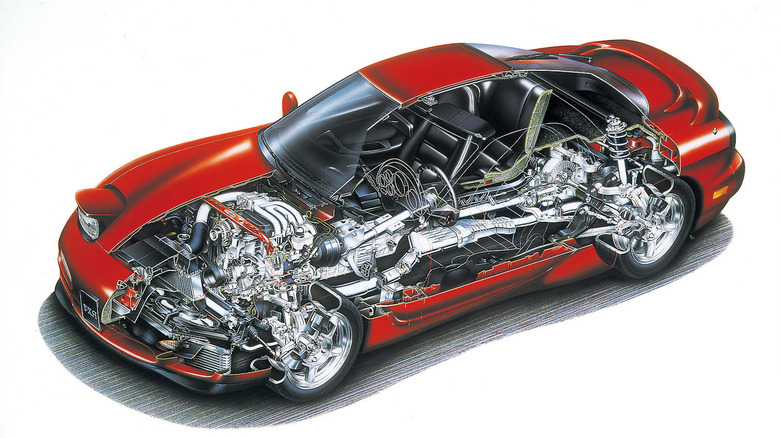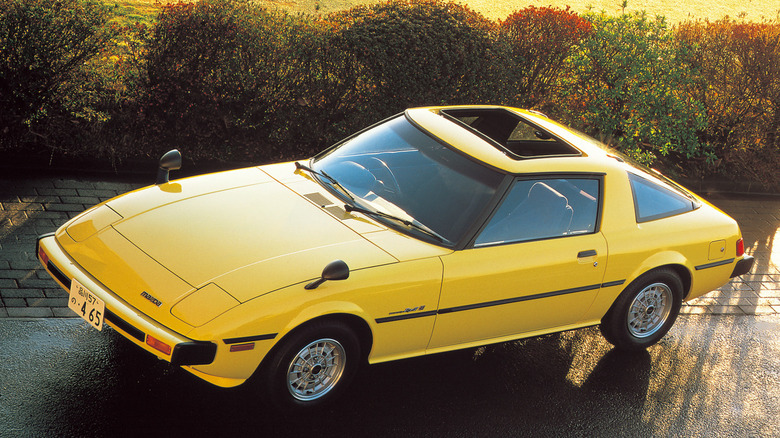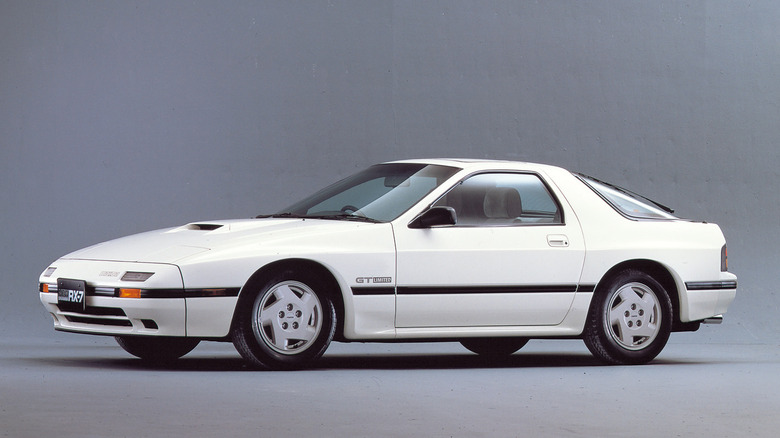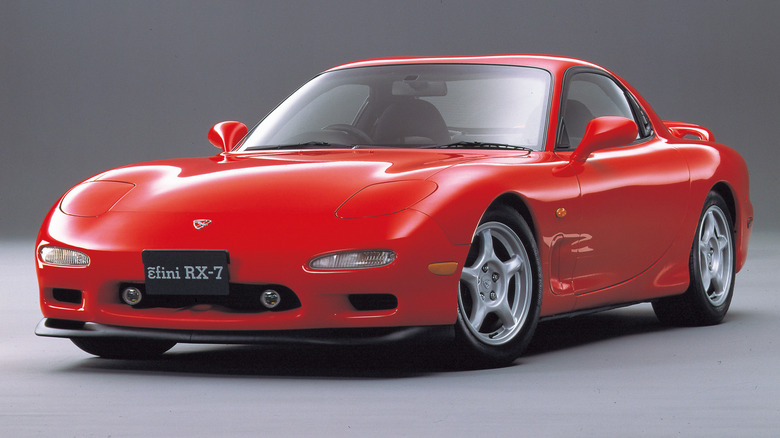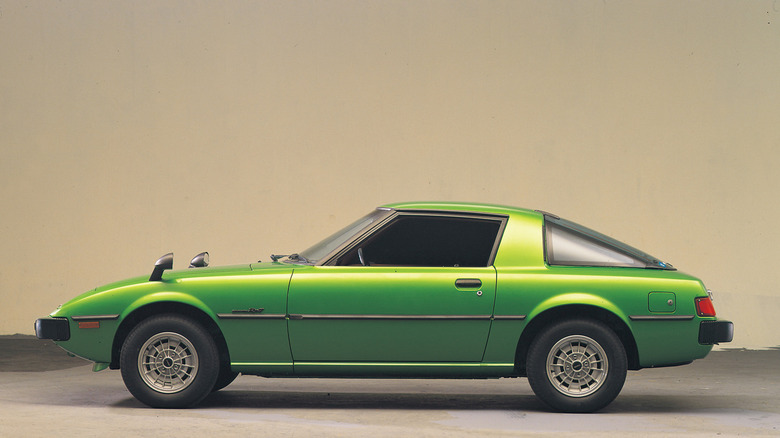Every Mazda RX-7 Generation, Ranked By Horsepower
The Mazda RX-7 went through three generations as Mazda's premier performance sports car, consistently powered by Mazda's rotary engine. Debuting in 1978, it remained in the U.S. Mazda lineup through 1995, although it continued to be sold in Japan until 2002. It is considered to be one of the cars that Mazda should have never discontinued.
As the only rotary-powered sports car of its day, the Mazda RX-7 was a unique concept that combined good design, excellent handling, and had an engine that could rev very smoothly to high rpms (by piston-engine standards) whenever you had the urge. Mazda actually built in a buzzer to remind drivers when the redline was reached so they could shift into the next gear.
The three generations of the Mazda RX-7 actually evolved in power output, unlike the engine power rankings of the Mazda Miata's generations. The RX-7's levels of horsepower steadily increased over time, helping to keep pace with the size and weight increases of each succeeding generation of Mazda's rotary-engined offering, while also improving its performance among competitors in the sports car market. A total of over 800,000 Mazda RX-7s were sold around the world before this unique sports car went out of production for good.
Mazda RX-7 SA22/FB (1979-85): 100 to 135 hp
The first generation of the Mazda RX-7 was intended to showcase Mazda as an innovator in engine technology by placing Mazda's rotary engine literally front and center in its new two-seater sports car. While two European automakers, France's Citroën and Germany's NSU, previously had disastrous experiences with Felix Wankel's rotary engine, Mazda was able to surmount the rotary's edge sealing problems and make it into a fairly reliable powerplant.
The first year of the Mazda RX-7 was 1978 and its initial base price was $7,195 MSRP. For that, buyers got a twin-rotor 12A rotary engine producing 100 horsepower and mounted behind the car's front axle, making it a front mid-engine layout. A five-speed manual transmission sent the rotary's power to the rear wheels. A Car and Driver test of a later 1984 RX-7 GSL-SE, with its revised interior and uprated 135-horsepower 13B engine, generated a zero-to-60 mph time of 7.8 seconds and a quarter-mile time of 15.9 seconds at a trap speed of 86 mph. Top speed was 125 mph and by the time that this first generation RX-7 reached the end of production in 1985, more than 471,000 examples of Mazda's sports car had been made for markets around the world. This represents nearly 59% of all the RX-7s that came off the production line for all three generations.
Mazda RX-7 FC (1987-92): 146 to 203 hp
The second generation of the Mazda RX-7 came on the scene for the 1987 model year. It featured an upgraded 13B twin-rotor rotary engine that now had 146 horsepower to move its weightier and larger platform and a redline of 7,000 rpm. This model of the RX-7 was aimed directly at its German competition — namely the Porsche 924 and 944 models. Notice the many similarities in styling between these two very different sports cars that were nevertheless very close rivals for the consumer's sports car dollar. Underneath its skin, the newer RX-7 offered a sophisticated independent rear suspension that featured innovative passive rear steering as well as four-wheel disc brakes.
When the Mazda RX-7 Turbo II was unleashed, it features 182 turbocharged hp and a zero-to-60 mph time of less than seven seconds. Numerous other variants of the RX-7 continued to appear, including a convertible in 1988, followed by a naturally-aspirated (NA), lighter-weight version called the GTU in 1989, which was a callout to the RX-7's IMSA racing successes. Model year 1989 also saw the addition of the Turbo II with upgraded output, now producing 203 hp from its two-rotor turbocharged engine. Performance of the Mazda RX-7 second-generation sports car, according to a Motor Trend test of a 1986 non-turbo version, put up numbers like 0-60 mph in 8.1 seconds, the quarter-mile going by in 16.34 seconds at 82 mph, and a top speed of 138 mph.
Mazda RX-7 FD (1993-95): 255 hp
The third generation of the Mazda RX-7 was the ultimate evolution of Mazda's sports car, in terms of both power and capability. These cars sit atop the list of the fastest Mazda cars ever made. Appearing in the U.S. market for a brief three model years, from 1993 through 1995, it stayed in production in Japan until 2002. This third generation has cemented the RX-7's place as one of the most iconic cars in JDM history. Its flowing styling still appears timeless, with form elegantly following function. The third-gen RX-7 was both wider and lighter than the previous generation.
Powered by yet another major development of the 13B twin-rotor engine, the third-generation RX-7 used two turbochargers arranged sequentially, with one providing boost to the engine at lower rpms and the other cutting in at around 4,500 rpm to improve the high-end response. All told, this was enough to generate 255 horsepower at 6,500 rpm, with a redline placed at 8,000 rpm. Yet the entire RX-7 weighed only 2,850 pounds.
This was the only engine to appear in the third-generation of the RX-7. A five-speed manual sent the power to the rear wheels. Performance stats of the third-gen Mazda RX-7 reinforce its credentials as the fastest RX-7 of them all. Car and Driver tests showed a 0-60 mph time of 5.3 seconds, a quarter-mile time of 14.0 seconds @ 100 mph, and a top speed of 157 mph.
What are Mazda RX-7s worth today?
The value of the Mazda RX-7 in today's market, like many collectible sports cars, has a lot to do with rarity, desirability, and condition. According to Classic.com sales over the past three months (as of this writing), first-generation RX-7s, which represent the majority of RX7s that were sold, can be had in original, unmodified condition for as low as $5,500 for a high-mileage example, going up to between $20,000 and $30,000 for a low-mileage car.
Second-gen Mazda RX-7s include NA, turbocharged, and convertible versions. These RX-7s, sold over the past three months on Classic.com, are available in original condition for as little as $4,500 to $8,300 for high-mileage NA coupes and convertibles. A low-mileage convertible recently brought $18,500 while a 1988 Turbo II Anniversary model has gone for $25,750.
Then we have the third-generation of the Mazda RX-7, which is both the most highly regarded and the least produced. Many of these cars that have been listed on Classic.com over the past three months have either been modified or are Japanese Domestic Market cars made after the end of U.S. production, between 1996 and 2002. This means that finding an original example made for the U.S. market is more difficult. These third-gen U.S.-market cars are priced significantly higher than the earlier RX-7 generations, with those in original condition going for $34,250 to $47,750. A low-mileage third-gen RX-7 recently sold for $81,000, signifying the value of these cars to collectors.
